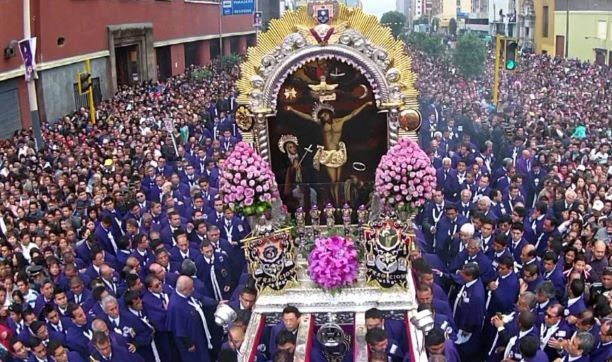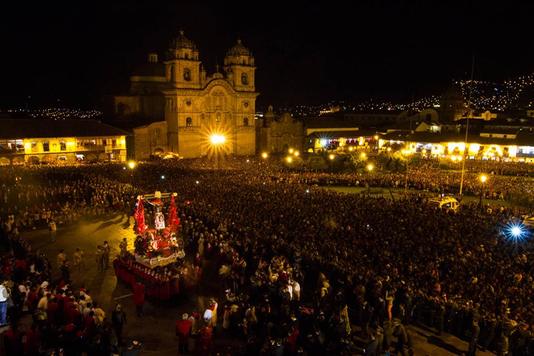Religion in Perú is also a heritage from the Conquest; For this reason, it is a mainly Catholic country (more than 75% of the population). With Catholicism, since the sixteenth century, expressions of a native religion based on the cult of the Sun, the Pachamama (Mother Earth) and the elements of nature in general have coexisted. Scholars are still not in agreement when deciding whether it is two very different religions in a process of fusion or a parallel of beliefs.
In addition, lately very diverse churches have appeared, in such a way that we can affirm that the Peruvian population is still very religious and that the percentage of declared atheists and agnostics is very low. We have, for example, Protestant churches fruit of the work of North American and European missionaries. Likewise, Jehovah’s Witnesses, Mormons, Adventists, Buddhists, Muslims, Hindus, Hare Khrishnas, etc.


Modern-day religions have also emerged, such as the Peruvian group Israelitas del Nuevo Pacto (which has the particularity of always participating in political elections), the New Era Movement (which has the characteristic of merging religion, philosophy, traditional customs, etc.) and other groups that have been responding to the need of people to fill the gaps that the last century has left in people.
Religious activity in Peru is important, considering that, for many people, one of the “energy centers” of the world is precisely in the city of Cusco.
In Peru, 96%, a very high percentage of the population, declare themselves believers. 93.8% of the country’s population practice Christianity, thus it is the religion most followed by its population.
In recent years the percentage of believers has decreased, from 96.9% to 96%. As for Christianity, it has also declined, in the previous survey 96% professed it and according to the latest data, 93.8% of the population profess it.
As a visitor to a foreign country, it is important to understand the religious norms of the host society. Peruvians, in general, are quite tolerant when it comes to religion, perhaps in part due to the country’s history.
Pre-colonial religious beliefs and traditions. mainly those of the Incas, they are still recognized and respected … if they are not widely practiced. The Inca gods are still known to many Peruvians, but their place in the religious perspective of the nation has been replaced by Catholicism.
Only Catholicism is directly mentioned in the 1993 Peruvian Constitution, but alternative beliefs and religious freedom are recognized. According to article 50 of the Constitution, the following is true.
Religion in Perú: Statistics
The National Census of Peru, completed in 2007, provides information on the religious attitude of the nation. The following statistics are for Peruvians aged 12 and over, totaling 20,850,502 (Peru has a total population of 29,248,943):
- Catholics: 16,956,722 (81.3%)
- Christian / Evangelical: 2,606,055 (12.5%)
- Others: 679,291 (3.3%)
- None: 608,434 (2.9%)
Catholicism
Catholicism is clearly the dominant religion, despite a 7.7% decline since the previous 1993 census. Interestingly, Catholicism is more dominant in urban areas (82%) than in rural areas (77.9%). In rural Peru, evangelical and non-evangelical Christians are more common (15.9% compared to 11.5% in urban areas).
Christians
Evangelical Christians include Lutherans, Calvinists, Baptists, and the Evangelical Church of Peru. Non-Evangelical Christians include Mormons, Seventh-day Adventists, and Jehovah’s Witnesses. In total, evangelicalism increased by 5.7% between 1993 and 2007. According to the website of the Church of Jesus Christ of Latter-day Saints (December 2011), the membership of the LDS church in Peru stands at 508,812.
Other religions
Other religions in Peru come mainly from immigrant communities that have come to the country in the last hundreds of years (mainly since the 19th century). 3.3% of the “other” religions include Jews, Muslims, Buddhists, Hindus, and Shinto.
Agnostics, atheists, and people without religious affiliation represent almost 3% of the Peruvian population. In terms of the administrative regions of Peru, the highest concentration of unaffiliated people occurs in the jungle departments east of the Andes (San Martín 8.5%; Ucayali 6.7%; Amazonas 6.5% and Madre de Dios 4.4%).
The fusion of Catholicism and pre-Columbian beliefs
Catholicism arrived in Peru in the 16th century with the arrival of the Spanish conquerors. The relentless conquest of the Inca Empire and the drive to spread Catholicism throughout the New World threatened the very existence of the Incas and their religious beliefs.
Despite the rapid fall of the Inca Empire, the Inca gods, their apu mountain spirits, and the traditional rites and beliefs of Inca society did not disappear from the national psyche. Modern Peru still harbors pre-Columbian traditions, although they are often fused with the dominant Catholic faith. Catholicism in Peru is imbued with imagery and ritual elements dating back to before the Spanish conquest, all of which can still be seen in the many religious festivals that take place throughout Peru throughout the year.
Religion in Perú for travelers
There are no major religious taboos that travelers should be aware of before going to Peru. In general, Peruvians are happy to accept the religious beliefs of others, as well as agnostic and atheistic views. Of course, there are times when religion, like politics, should be avoided or treated with caution as a topic of conversation. It is up to you if you want to broach the subject. As long as you don’t insult someone else’s faith, you should be able to have a civil conversation.
Other religious considerations are pretty standard, including etiquette for visiting churches and cathedrals in Peru. You should always treat religious buildings, icons, and other faith-related items with great respect. If you go into a church, for example, you must take off your hat. If you want to take photos inside a church or cathedral, make sure photography is allowed and be careful with your flash (churches are built for the faithful, not tourists).
If you visit Perú, we recommend you to visit another impressive destinations in Cusco like the rainbow mountain tour, the humantay lake tour, or the sacred valley tour, which only takes one day. But if you are gonna to stay more days in Perú, other archaeological places you can know will be the machu picchu day tours from cusco.










